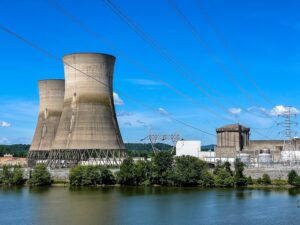About 20% of Minnesota’s electricity comes from nuclear power plants. Nuclear power provides an important supplement to solar and wind power. Like them, it doesn’t emit CO2, but unlike them it generates a consistent supply of electricity. As we discussed previously, wind turbines in the upper Midwest can operate at temperatures as low as -22 ˚F. However, normally the wind doesn’t blow when it’s that cold, so alternative sources of electricity are necessary.
In addition, both solar- and wind farms can take up a lot of space, while nuclear power plants have a much smaller footprint. That makes them less objectionable to some of their potential neighbors.
But the biggest reason the nuclear sector is popping champagne [corks] is the billions of dollars the Biden administration is pumping into nuclear development via the Inflation Reduction Act, which made nuclear power eligible for the same tax credits as renewables like wind and solar; and the Infrastructure Investment and Jobs Act of 2021, which created a $6bn fund to help keep existing plants running. The Biden administration is even offering developers a bonus tax break if they build reactors in fossil-fuel areas, such as a coal-mining town, to funnel workers into green jobs, a core tenet of Joe Biden’s industrial policy. Nuclear’s green makeover, and all of the federal cash on offer, have its boosters predicting an atomic renaissance after decades in the dark ages.—The Economist, 25 June 2023

The legacy of Three Mile Island
Despite high-profile accidents at Three Mile Island and Chernobyl, nuclear power has a good safety record.
Indeed, lessons learned from the Three Mile Island accident in 1979 drove improvements in nuclear safety. Design and operating procedures for nuclear power plants throughout the West have improved as a result. The Nuclear Regulatory Commission has instituted much higher safety standards and stricter enforcement.
Unfortunately, popular perception of nuclear safety is probably closer to that portrayed in The Simpsons. And the lack of understanding of science and technology doesn’t engender public confidence in nuclear power. In addition, the cost and time to build new nuclear power plants can present significant barriers to deployment.
Video: Homer Simpson narrowly averts a nuclear meltdown.
Chernobyl
A flawed reactor design, poor operator training, and cavalier attitudes toward safety led to the Chernobyl incident in 1986. These failures stemmed from the Cold War-era isolation of the USSR. Chernobyl was far more serious than Three Mile Island, killing two people in the explosion and 28 from acute radiation exposure.
The disaster highlighted additional failures of the Soviet system. The government didn’t even warn local residents to stay indoors and close their windows to limit radiation exposure.
The first warnings of radiation leaks came from Sweden. Two days after the accident, a radiation monitor at the Forsmark nuclear plant detected excessive radiation on an employee’s shoes. Plant workers couldn’t find any radiation leaks at Forsmark. However, they did identify radioactive particles characteristic of Russian nuclear reactors. They alerted the Swedish government, which alerted the rest of the world.
The Chernobyl disaster was a unique event and the only accident in the history of commercial nuclear power where radiation-related fatalities occurred. The design of the reactor is unique and in that respect the accident is thus of little relevance to the rest of the nuclear industry outside the then Eastern Bloc. However, it led to major changes in safety culture and in industry cooperation, particularly between East and West before the end of the Soviet Union. Former President Gorbachev said that the Chernobyl accident was a more important factor in the fall of the Soviet Union than Perestroika…—World Nuclear Association
For years afterward, there was concern about radioactive contamination in the rest of Europe, particularly Scandinavia. In Norway in 1989, I saw a newspaper ad addressing fears about the safety of reindeer meat, which is important to the livelihood of the Sami people. “The reindeer selects only the best moss to eat,” it assured the reader.
Nuclear power plants in Minnesota
The public’s doubts about nuclear safety, costs, and construction delays have limited the construction of nuclear power plants in the US. The average age of nuclear plants in this country is 40 years. Now, though, with concern for global warming at an all-time high, utilities all over the country are rethinking their plans to retire older plants.
Xcel Energy operates nuclear power plants in Monticello and Red Wing, Minnesota. The NRC originally licensed them for 40 years’ operation, later extending the licenses for an additional 20 years. Xcel is applying to extend Monticello’s license for another 20 years and plans to do the same for the plant in Red Wing.
“Many things degrade over time, so safety depends on how well aging is managed,” said David Lochbaum, a nuclear safety engineer formerly with the Union of Concerned Scientists. “If you are replacing your parts that wear out, you can operate safely for 70 to 80 years.”—Star Tribune, 17 June 2023
Xcel has replaced most of the major components of its plants and has a good record for safe operations.
